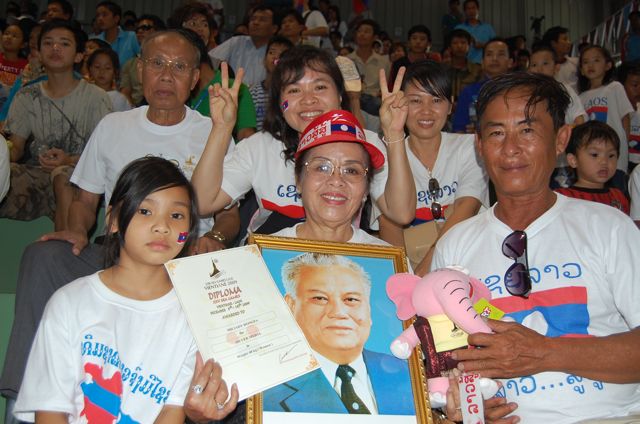If the 25th SEA Games represent a regional coming out for Laos, they have been a grand success. Virtually complete with the exception of Friday’s closing ceremony, the event has exceeded expectations on a number of levels.
Most importantly for the Lao fans, the national team has easily surpassed its pre-games target of 25 gold medals, having won 32 at the time of writing. The men’s football team, which ultimately failed to win a medal, nevertheless made it through to the semi-finals for the first time in living memory, providing an unparalleled locus for popular support. Off the field, organisation has experienced few hitches, leaving most observers, including senior organisers, pleasantly surprised. There have been some complaints of course, but mostly minor. ‘Better than expected’ has been the theme here, from Lao and foreign watchers alike.
Just as the games have been a boon for Laos, so they have boosted the Lao People’s Revolutionary Party (which has run the country since 1975) as official and popular nationalism has rolled into one. I’ve already mentioned the presence at football matches of portraits of revolutionary leaders. At the women’s boxing on Tuesday it was the proud mother of a Lao silver medallist who held a framed picture of Kaysone Phomvihane in the crowd after her daughter had taken it onto the dais. The mother’s motivations were in fact quite local. ‘He was from Savannakhet [southern Laos] and so are we’, she explained, but the nuance was lost on the crowd, who whooped and cheered at the portrait as they had at the football earlier in the week.
This is the tip of a very large blue, red and white iceberg in the pattern of the Lao national flag. Indeed, the patriotic fervour of the past two weeks – and the attendant national pride – is the defining aspect of the games for almost all of the Lao I have spoken to.
But the irony, of course, is that the SEA Games are a regional event with the aim of promoting regional ‘solidarity, friendship and peace’. I know this not only because it’s the official ideology of the games but because many of the people I’ve talked to – officials and general population – have told me this as well. Here is a classic example of why official rhetoric cannot be dismissed as ‘mere words’. If you say something often enough, it may well become the truth, and this does not need to take long.
This seems especially true in Southeast Asia, where national histories – like attempts at regional integration – mostly date from after the Second World War. This point struck me with particular force when I was speaking to a low level official while watching athletics together. This man explained that, while Laos had a long history of engagement with Vietnam, Thailand and Cambodia, the ‘modern’ relationships with other ASEAN countries like Singapore and Malaysia were equally important and not the least bit artificial for their recent history. Likewise, a Lao woman I’ve known for years said (before I could even ask her opinion) that there could be no turning back after these games, which would forever leave Laos with a ‘perspective of the region’.
Both informants recognised the complexity of regional association: the first emphasised that Southeast Asian countries were also members of a bigger group – Asia – while the second was not sure that the ‘region’ was really clear at all. Nevertheless, in both these examples – and I could give many more – history does not need the appearance of timelessness to be real. The fact that these countries are grouped together in ASEAN (except Timor Leste) and the SEA Games makes them the ‘region’. In this sense the region is a self-fulfilling prophecy. Primordialism can be saved for the nations that make up the region.
But at the same time, the strength of nationalist motifs in the SEA Games – especially from the host country – leaves little oxygen for the regional dimension. This was confirmed in a conversation I had with a judge who rued that ‘people just want to win’ and suggested some ‘manipulation of results’ had taken place in his sport by and to the advantage of Laos and Vietnam.
I did not see the event in question and, in any case, would not be able to judge the veracity of his claim. But this is almost beside the point. What matters here is the allegation of impropriety, instances of which seem to arise at every SEA Games (and, of course, in other international sporting events). This man made it clear that he looked down on Laos for its relationship with Vietnam, both in this alleged incident and more generally, providing a counterpoint to the positive view of the relationship evident elsewhere in the games. In other words, the experience had the effect of crystallising the man’s antipathy towards Vietnam and extending it to Laos – in stark contrast to the objectives of the games.
So are the SEA Games, like regional integration more generally, a ‘political version of Esperanto’, a ‘club of sharks ready to risk being eaten alive’, as a provocative comment to an earlier post suggested?
Certainly the nationalist aspects of the games give this interpretation some plausibility. But I feel the SEA Games cannot be reduced to one or the other of its nationalist and regional themes. Rather, the event realises both similtaneouly – which, I’d suggest, is why it has been such an enduring, adaptable and increasingly important institution in the region since being founded (as the Southeast Asian Peninsula Games) in 1959. The challenge is to examine the different elements and participants in the games – symbols, rituals, organisation, competitions, media coverage, athletes, spectators, journalists, organisers, etc – to determine which parts do what, some examples of which I’ve offered in this post. A second challenge is to consider how these factors have changed over time with other historical developments.
I would be happy to hear your thoughts.
 Facebook
Facebook  Twitter
Twitter  Soundcloud
Soundcloud  Youtube
Youtube  Rss
Rss 
